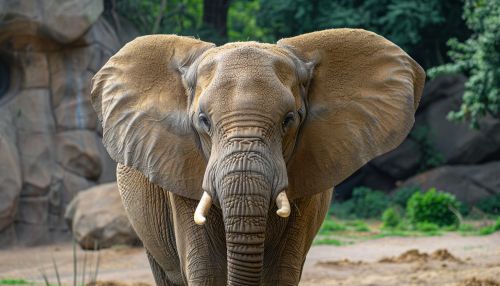Elephant
Taxonomy and Evolution
Elephants belong to the family Elephantidae, a part of the order Proboscideans, which also includes extinct species like the mastodons and mammoths. The family Elephantidae is divided into two extant (living) genera: Loxodonta, the African elephants, and Elephas, the Asian elephant.
The evolution of elephants has been a topic of interest for many scientists. The earliest known proboscideans, the clade that contains the modern elephants, existed about 55 million years ago in Africa. Over time, they evolved and diversified, leading to the emergence of the modern elephants.
Anatomy and Morphology
Elephants are known for their distinctive features. They have a long, muscular trunk, large ears, and tusks, which are modified incisor teeth. The trunk is a fusion of the nose and upper lip and is highly sensitive and versatile, capable of a wide range of movements. The large ears aid in heat dissipation due to the numerous blood vessels present.
Elephants are the largest land animals, with males standing up to 4 meters at the shoulder and weighing up to 7,000 kilograms. Despite their size, they have a relatively low metabolic rate, which helps them to survive in different environments, from the African savannahs to the Asian rainforests.


Behavior and Ecology
Elephants are highly social animals, living in matriarchal family groups. These groups are led by the oldest female and consist of her daughters and their offspring. Males leave the family group when they reach puberty and may lead solitary lives or form loose associations with other males.
Elephants are herbivores, feeding on a variety of vegetation, including grasses, leaves, and bark. They need to consume large quantities of food — up to 150 kilograms per day — and spend up to 16 hours a day eating.
Elephants play a crucial role in their ecosystems. They are considered 'keystone species' due to their impact on the environment. For instance, by feeding on trees and shrubs, they help to maintain the savannah ecosystem in Africa.
Conservation
Elephants are currently facing numerous threats, primarily from habitat loss and poaching for ivory. Both African and Asian elephants are listed as vulnerable by the IUCN, with some subspecies listed as endangered.
Conservation efforts for elephants are focused on both protecting their natural habitats and reducing poaching. These efforts include establishing protected areas, enforcing anti-poaching laws, and promoting community-based conservation programs.
Cultural Significance
Elephants have been revered in various cultures for their strength and intelligence. They have been featured in religions, folklore, and art. In Hinduism, the elephant-headed god Ganesh is worshipped as the remover of obstacles. In Africa, elephants are often seen as symbols of wisdom and power.
